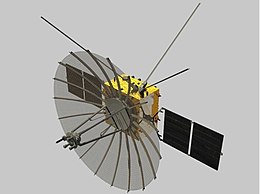 Rendering of Queqiao satellite | |
| Mission type | Communication relay Radio astronomy |
|---|---|
| Operator | CNSA |
| COSPAR ID | 2018-045A |
| SATCAT no. | 43470 |
| Mission duration | Planned: 5 years 6 years, 6 months, 4 days (in progress) |
| Spacecraft properties | |
| Bus | CAST100[1] |
| Manufacturer | DFH Satellite Company LTD |
| Launch mass | 448.7 kilograms (989 lb)[1] |
| Dry mass | 325 kilograms (717 lb) |
| Dimensions | Satellite: 1.4 × 1.4 × 0.85 m[1] Antenna: 4.2 metres (14 ft) in diameter[1] |
| Power | 800W[1] |
| Start of mission | |
| Launch date | 20 May 2018 21:28 UTC[2] |
| Rocket | Long March 4C[2] |
| Launch site | Xichang LC-3[2] |
| Orbital parameters | |
| Reference system | Halo orbit |
| Earth-Moon L2 point orbiter | |
| Orbital insertion | 14 June 2018[3] |
Queqiao satellites | |
Queqiao relay satellite (Chinese: 鹊桥号中继卫星; pinyin: Quèqiáo hào zhōngjì wèixīng; lit. 'Magpie Bridge relay satellite'), is the first of the pair of communications relay and radio astronomy satellites for the Chinese Lunar Exploration Program. The China National Space Administration (CNSA) launched the Queqiao relay satellite on 20 May 2018 to a halo orbit around the Earth–Moon L2 Lagrangian point[4][5] Queqiao is the first communication relay and radio astronomy satellite at this location.[3]
The name Queqiao ("Magpie Bridge") was inspired by and came from the Chinese tale The Cowherd and the Weaver Girl.[4]
- ^ a b c d e Cite error: The named reference
final-designwas invoked but never defined (see the help page). - ^ a b c Cite error: The named reference
nasaspaceflifgt-launchwas invoked but never defined (see the help page). - ^ a b Cite error: The named reference
P Society Luyuan Xuwas invoked but never defined (see the help page). - ^ a b Cite error: The named reference
space-wallwas invoked but never defined (see the help page). - ^ "Queqiao". NASA.